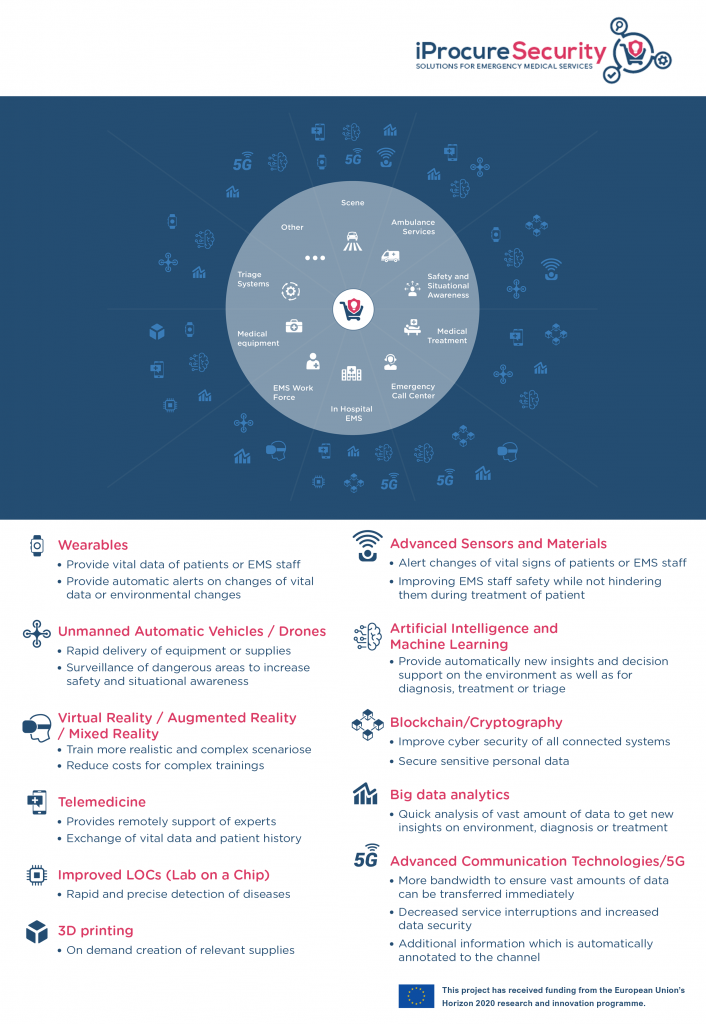The iProcureSecurity project started in May 2019 and run until December 2020. It brought together 10 organisations working in the field of Emergency Medical Services (EMS) from seven different countries in Europe.
During these twenty months the consortium identified the major challenges the system’s diversity poses to the capability of working together, stimulated R&I uptake with a focus on increasing standardisation of operations across Europe while delivering technical requirements for R&I activities to prompt a more homogeneous European Emergency Medical Services Systems.
Challenge: Emergency Medical Services in Europe as a very fragmented landscape, including a broad range of different practitioners. The Covid-19 pandemic sadly confirmed this state of fact, e.g. when transferring patients from a country to another country
The role of JOIN was to identify all categories of stakeholders linked with the EMS field (practitioners, experts, public institutions, hospitals, industry, businesses and insurances) and to mobilise them. Similarly, JOIN collected all the existing initiatives, networks and research projects in the field.
One of the main engagement activity was to create an online community of practice, the EMS Network, where all the stakeholders can come together and share knowledge on a wide range of topics.
The consortium also analysed the European Emergency Medical Services ecosystem, its capability gaps, challenges and needs. This was carried out through different activities: analytical research, surveys and questionnaires submitted to stakeholders across all Europe, organisation of webinars and workshops, etc. Moreover, the consortium has recently became a liaison member of the European Committee for Standardisation.
Consequently, 10 different priority areas for Research & Innovation in the field of EMS were identified, including 81 possible different challenges and therefore 81 possible different needs.

Given the current Covid-19 pandemic, the consortium decided to focus on one precise area: triage management.
The consortium identified how flexible triage management should be in order to provide a quick and accurate overview of casualties and their status, decision support for better allocation of available resources and quicker support for patients. Among other important aspects there are the improved interoperability with other first responders and relevant actors, and reduced handover times between ambulance transport and hospitals.
Follow-up Project: Pre-Commercial Procurement (PCP)
The iProcureSecurity project officially ended in December 2020 and its findings will be used in the frame of a Pre-Commercial Procurement.
Public sector challenges require improvements that are so technologically demanding that there are no near-to-the-market solutions yet and new R&D is needed.
PCP can then be used to compare the pros and cons of alternative competing approaches and to de-risk the most promising innovations step-by-step via solution design, prototyping, development and first product testing.
Pre-Commercial Procurement (PCP) is an approach for contracting authorities to acquire research and development services (and under certain conditions related R&D results), with the purpose of steering the development of new innovations towards public sector needs, without committing to engage in a follow-up Public Procurement of the Innovative solutions (PPI) emerging from the PCP.
The nature of a PCP is for public procurers to provide funding to suppliers developing R&D services not available on the market yet. It is divided into different competitive phases, in which the suppliers develop their solutions to address the procurement challenge.
Curiosity Driven Research (phase 0): Open Market Consultation to raise the interest of suppliers, followed by the Call for tender.
Solution Design (phase 1): The PCP consortium and external experts will evaluate the bids and select a minimum of four suppliers to develop their solutions.
Prototype development (phase 2): Interim evaluations by an expert review board will continuously improve the prototypes while developing them.
Original Development & Operational Testing (phase 3): A minimum of two suppliers will be selected to test their prototypes under real-life situations.
The potential buyers represent the demand side of the PCP, playing a key role in the procurement strategy and, ultimately, in the final solutions’ use.

